BL 15-pounder gun
The Ordnance BL 15-pounder, otherwise known as the 15-pounder 7 cwt, was the British Army's field gun in the Second Boer War and some remained in limited use in minor theatres of World War I. It fired a shell of 3-inch diameter with a maximum weight of 15 pounds (6.8 kg), hence its name which differentiated it from its predecessor '12-pounder' 3-inch gun which fired shells weighing only 12.5 pounds (5.7 kg).[note 1]
| Ordnance BL 15-pounder | |
|---|---|
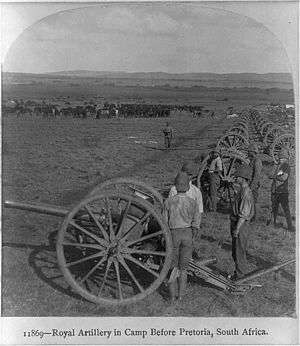 15-pounder in South Africa during the Second Boer War | |
| Type | Field gun |
| Place of origin | United Kingdom |
| Service history | |
| In service | 1892–1918 |
| Used by | British Empire |
| Wars | Second Boer War World War I |
| Specifications | |
| Barrel length | 84-inch[1] |
| Shell | Separate loading BL, 14 lb (6.4 kg) shrapnel |
| Calibre | 3-inch (76.2 mm) |
| Elevation | -5° - 16°[1] |
| Rate of fire | 7-8 rds/min[2] |
| Muzzle velocity | 1590 ft/s[3] |
| Maximum firing range | 6000 yds[4] |
History
The gun was a modified version of the previous BL 12-pounder 7 cwt gun of 1883. When the modern smokeless propellant cordite replaced gunpowder in 1892 it was decided that the 12-pounder was capable of firing a heavier shell up to 15 lb (6.8 kg). A 14-pound shell was adopted and the gun was renamed a 15-pounder.[5]
Mk I carriage : recoil was controlled by drag-shoes. These were placed under the wheels, and were connected by chains and cables to the wheel hubs and the trail.[6]
Mk II carriage : this had the same drag-shoe system and also a hydraulic buffer. This only allowed a short recoil, and was not successful.[6]
Mk III carriage : In 1899 a rudimentary recoil system was added, consisting of a "spade" beneath the axle which dug in when the gun recoiled, connected by a steel wire to a spring in a cylinder on the trail. Mk I and II carriages fitted with these were known as Mk 1* and Mk II*. The latter retained the hydraulic buffer.[6]
Although the whole gun jumped and moved backwards on firing, the spring returned it to firing position and hence still increased the rate of fire compared to the old model without any recoil mechanism.[7] Hogg and Thurston comment ironically : "It is said that it checked it [recoil] so well that the gun usually recoiled 1 foot and jumped forward 2 feet".[8]
Other Mks of carriage followed, all with axle-spades, but without buffers.
From 1904 the BL 15-pounder was superseded by the modern QF 18-pounder. Remaining BL 15-pounders were upgraded as the BLC 15-pounder to equip the Territorial Force with an "ersatz QF gun".[7]
Combat use
The gun was normally towed by 6 horses, in 3 pairs.
Second Boer War
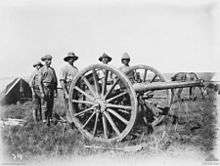
349 guns were in service in the Second Boer War 1899–1902 and fired 166,548 shells out of the British total of 233,714.[9]
While the gun could fire a shell up to approximately 5800-5900 yards, the No. 56 time and percussion fuze in use in 1899 could only be set for a maximum timed range of 4100 yards because it only burned for 13 seconds. The shrapnel shells in use were usually time-set to burst in the air above and in front of the enemy. Hence the gunners had to get within approximately 4200 yards of the enemy to fire on them. The fuze could be set to explode on contact (percussion) up to the maximum range, but shrapnel exploding on contact was of little use. This was rectified later in the war by the No. 57 "blue fuze" which could be time set up to 5800-5900 yards.[10][11]
World War I
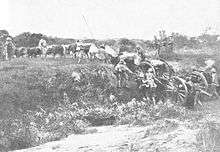
7th Field Battery (4 guns, originally No. 2 and No. 6 Light Batteries) towed by oxen and known as the Oxo Battery and manned by Mauritian and South African gunners fought in the German East Africa campaign in World War I.[12]
Ammunition
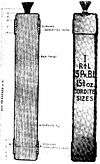 |
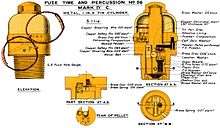 |
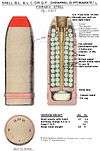 |
 |
 |
as used in Second Boer War |
See also
- Ordnance BLC 15-pounder : modernised version
- Field artillery
- List of field guns
Weapons of comparable role, performance and era
- 7.7 cm FK 96 German equivalent
Surviving examples
- HM Royal Armouries Fort Nelson, Fareham, Hampshire, England
- At the Royal Artillery Museum, Woolwich, London
Notes
- The British at that time traditionally identified smaller guns by the maximum weight of shell they could fire, arbitrarily rounded up or down.
References
- Hogg & Thurston 1973, page 71
- Hall June 1971
- Hogg & Thurston 1974 quote 1,590 ft/s (480 m/s) in WWI. Hall December 1972 quotes 1,574 ft/s (480 m/s) in the Second Boer War. The difference may be the propellant.
- Hogg & Thurston 1972 quote 6000 yards in WWI. Hall June 1971 quotes 5600 yds in the Second Boer War.
- Clarke 2004, page 17-18
- Hall, June 1973
- Clarke 2004, page 18
- Hogg & Thurston 1972, page 70
- Appendices 28 and 29 of the Royal Commission on the War in South Africa
- Hall, December 1975
- Hall, December 1972
- Farndale 1988, page 316
Bibliography
- Dale Clarke, British Artillery 1914–1919. Field Army Artillery. Osprey Publishing, Oxford UK, 2004 ISBN 978-1-84176-688-1
- General Sir Martin Farndale, History of the Royal Regiment of Artillery : Forgotten Fronts and the Home Base 1914–18. London: Royal Artillery Institution, 1988. ISBN 978-1-870114-05-9
- Major Darrell D. Hall, "Guns in South Africa 1899–1902" in The South African Military History Society. Military History Journal – Vol 2 No 1, June 1971
- Major Darrell D. Hall, "Field Artillery of the British Army 1860–1960. Part I, 1860–1900" in The South African Military History Society. Military History Journal – Vol 2 No 4, December 1972 (web page is incorrectly titled 1900–1914)
- Major Darrell D. Hall, "Field Artillery of the British Army 1860–1960. Part II, 1900–1914" in The South African Military History Society. Military History Journal – Vol 2 No 5, June 1973
- Major Darrell D. Hall, "AMMUNITION: 15-PR 7 cwt BL". in The South African Military History Society Military History Journal – Vol 3 No 4, December 1975
- I.V.Hogg & L.F. Thurston, British Artillery Weapons & Ammunition 1914–1918. London: Ian Allan, 1972. ISBN 978-0-7110-0381-1
External links
| Wikimedia Commons has media related to BL 15 pounder Gun. |
- Handbook for the 15-pr B.L. gun mark I Field batteries 1896
- Handbook for the 15-pr B.L. gun mark I Field batteries 1900
- Handbook for the 15-pr B.L. gun mark I Field batteries 1903
- Handbook for the 15-pr. B.L. gun field batteries 1904 at State Library of Victoria
- COLESKOP and the ARMSTRONG 15-POUNDER BL
- Mk III carriage diagram from Victorian Forts and Artillery website Society website
- Mk IV carriage diagram from Victorian Forts and Artillery website Society website